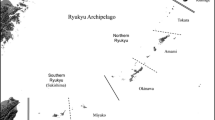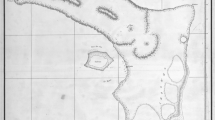Abstract
The northernmost part of the North American continent has seen some of the most fascinating human adaptations anywhere. In the New World this huge area extends some 11,000 km from the Aleutian Islands in the west to Greenland and Labrador in the east (Fig. 25.1). Geographically and in terms of human occupations, the Arctic is perhaps best defined as the area beyond the tree line (the northern limit of continuous forest). Some other attributes that help define the Arctic include persistence of cold (long winters and short cool summers), a largely treeless environment, permafrost (year-round frozen ground), large seasonal differences in the amount of sunlight, and very few plant foods that are consumable by humans. At the time of initial European contact a majority of human groups inhabiting the North American Arctic spent at least a part of the year living near the coast and making use of both land mammals on the tundra and sea mammals in the open ocean during the summer. However, in the winter the landscape changes dramatically.
Access this chapter
Tax calculation will be finalised at checkout
Purchases are for personal use only
Similar content being viewed by others
References
Alt BT, Koerner RM, Fisher DA, Bourgeois JC (1985) Arctic climate during the Franklin era, as deduced from ice cores. In: Sutherland PD (ed) The Franklin era in Canadian arctic history 1845–1859. Canadian Museum of Civilization, Archaeological Survey of Canada, Hull, pp 69–92
Boas F (1888) The central Eskimo. Annual Report of the Bureau of American Ethnology 6:399–669
Burch ES (1976) The "Nunamiut" concept and the standardization of error. In Hall ES, Jr. (ed) Contributions to anthropology: The interior peoples of north Alaska. Canadian Museum of Civilization, Archaeological Survey of Canada, Ottawa, pp 52–97
Dredge L (1991) Raised marine features, radiocarbon dates, and sea level changes, eastern Melville peninsula, arctic Canada. Arctic 44:63–73
Dunbar MJ (1981) Physical causes and biological significance of polynyas and other open water in sea ice. In: Stirling I, Cleator H (eds) Polynyas in the Canadian arctic. Environment Canada, Ottawa, pp 29–43
Dunbar MJ (1984) The biological significance of sea ice. In: Cooke A, Van Alstine E (eds) Sikumiut: The people who use the sea ice. Canadian Arctic Resources Committee, Ottawa, pp 7–30
Ferguson MAD, Williamson RG, Messier F (1998) Inuit knowledge of long-term changes in a population of arctic tundra caribou. Arctic 51:201–219
Freskild B (1996) Holocene climatic changes in Greenland. In Grønnow B (ed) The paleo-eskimo cultures of Greenland — new perspectives in greenlandic archaeology. Danish Polar Center, Copenhagen, pp 243–251
Friesen TM, Arnold CD (2008) The timing of the Thule migration: New dates from the western Canadian arctic. American Antiquity 73:527–538
Grønnow B (1996) The Saqqaq tool kit—technological and chronological evidence from Qeqertasussuk, Disko Bugt. In: Grønnow B (ed) The paleo-eskimo cultures of Greenland — new perspectives in greenlandic archaeology. Danish Polar Center, Copenhagen, pp 17–34
Henshaw AS (2003) Polynyas and ice edge habitats in cultural context: Archaeological perspectives from southeast Baffin island. Arctic 56:1–13
Jacobs JD (1979) Climate and the Thule ecumene. In: McCartney AP (ed) Thule Eskimo culture: An anthropological retrospective. Canadian Museum of Civilization, Archaeological Survey of Canada, Ottawa, pp 528–540
Jacobs JD, Headley AN, Maus LA, et al. (1997) Climate and vegetation of the interior lowlands of southern Baffin island: Long–term stability at the low arctic limit. Arctic 50:167–177
Jenness D (1922) The life of the Copper Eskimos. FA Acland, Ottawa, 277 pp
LeMoine GM, Helmer JW, Hanna DT (1998) Altered states: Human/animal transformational images in Dorset art. In: Ryan K, Crabtree PJ (eds) The symbolic role of animals in archaeology. Museum Applied Science Center for Archaeology (MASCA), Philadelphia, pp 38–49
Mason OK, Gerlach SC (1995) Chukchi hot spots, paleo–polynyas, and caribou crashes: Climatic and ecological dimensions of north Alaska prehistory. Arctic Anthropology 32:101–130
Maxwell MS (1985) Prehistory of the eastern arctic. Academic Press, Orlando, 327 pp
McCartney AP (1991) Canadian arctic trade metal: Reflections of prehistoric to historic social networks. In: Ehrenreich RM (ed) Masca research papers in science and archaeology, vol. 8, part 2. Museum Applied Science Center for Archaeology (MASCA), Philadelphia, pp 26–43
McCartney AP, Mack DJ (1973) Iron utilization by Thule Eskimos of central Canada. American Antiquity 38:328–338
McGhee R (1969–70) Speculations on climatic change and Thule culture development. Folk 11–12:173–184
McGhee R (1977) Ivory for the sea woman: The symbolic attributes of a prehistoric technology. Canadian Journal of Archaeology 1:141–149
McGhee R (1984) The timing of the Thule migration. Polarforschung 54:1–7
McGhee R (1985) Ancient animals: The Dorset collections from Brooman point. In: Driscoll B (ed) Uumajut: Animal imagery in Inuit art. Winnipeg Art Gallery, Winnipeg, pp 21–30
Morrison DA (1999) The earliest Thule migration. Canadian Journal of Archaeology 22:139–156
Murray MS, Robertson AC, Ferrara R (2003) Chronology, culture and climate: A radiometric re-evaluation of late prehistoric occupations at Cape Denbigh, Alaska. Arctic Anthropology 40:87–105
Park RW (1993) The Dorset–Thule succession in arctic North America: Assessing claims for culture contact. American Antiquity 58:203–234
Park RW (2000) The Dorset–Thule succession revisited. In: Appelt M, Berglund J, Gulløv HC (eds) Identities and cultural contacts in the arctic. The Danish National Museum & Danish Polar Center, Copenhagen, pp 192–205
Park RW (2003) The Dorset culture longhouse at Brooman Point, Nunavut. Études/Inuit/Studies 27:239–253
Rasmussen K (1932) Intellectual culture of the Copper Eskimos Gyldendalske Boghandel, Nordisk Forlag, Copenhagen, 350 pp
Schledermann P (1976) The effect of climatic/ecological changes on the style of Thule culture winter dwellings. Arctic and Alpine Research 8:37–47
Schledermann P (1980) Polynyas and prehistoric settlement patterns. Arctic 33:292–302
Taylor WE, Jr., Swinton G (1967) Prehistoric Dorset art. The Beaver Outfit 298:32–47
Author information
Authors and Affiliations
Corresponding author
Editor information
Editors and Affiliations
Rights and permissions
Copyright information
© 2010 Springer Science+Business Media B.V.
About this chapter
Cite this chapter
Park, R.W. (2010). Frozen Coasts and the Development of Inuit Culture in the North American Arctic. In: Martini, I., Chesworth, W. (eds) Landscapes and Societies. Springer, Dordrecht. https://doi.org/10.1007/978-90-481-9413-1_25
Download citation
DOI: https://doi.org/10.1007/978-90-481-9413-1_25
Published:
Publisher Name: Springer, Dordrecht
Print ISBN: 978-90-481-9412-4
Online ISBN: 978-90-481-9413-1
eBook Packages: Earth and Environmental ScienceEarth and Environmental Science (R0)




